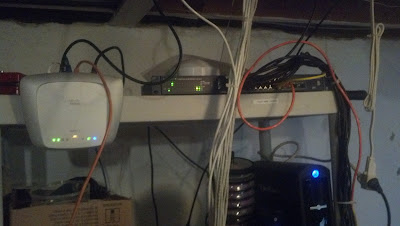I work for a school district's technology department. I love my job, but most nights after work I'm exhausted. That doesn't stop me from being on my computer for...well...the rest of the time that I'm awake. This stuff is how I make my living and, more importantly, how I enjoy myself. I like solving problems, fixing stuff and building things from the ground up (mainly networks, of course). All that being said, prepare for the nightmare that is my basement.
This first picture is an overview of what my home network looks like. (To me, it's the most amazing thing in the world. Not really, but whatever.) From the top left to the bottom right, the first item is my router. It's a Cisco Valet Plus M20 running DD-WRT. Great router, never really had any huge issues with it. It just sits there and works, passing packets right along. Cost me $60 USD on clearance.
Next up (top right): my NETGEAR GS724T Gigabit switch. This switch handles all the traffic in my house. It's basically what you would call an MDF (Main Distribution Frame).
Next shelf down on the left is my patch panel. Nothing special there, but it was a steal: the panel itself cost no more than approximately $25 USD and the bracket holding it cost about $20, so $45 total (no duh, Sherlock). It's Cat5e and that's where all the Ethernet wires around my house feed from. The color code is basic: black wires = standard, non-PoE ports, all Gigabit; the yellow wires are standard PoE ports for my access points; the orange wire is the VLAN for my family's laptop; finally the gray wire is the port outside (disconnected from obvious reasons). Also on this shelf is my UPS, which literally powers my entire network and is connected to the server to shut it down in the event of a power outage. Finally on this shelf is my Motorola SB6121 modem.
Moving down one more shelf is my server (in the picture there is an external drive running backups): this thing is a beast. 16GB RAM, two quad-core Intel Xeon processors, two 80GB 7200rpm drives (RAID 1) and two 1TB 7200rpm drives (RAID 1 as well). It's running two virtual machines (one for FOG imaging and the other as a second DNS server). It's my pride and joy and cost me a whopping $339 USD. Also, my outside access point is on top of the server just chillin' out.
The final shelf in the picture is my wireless system, consisting of an Aruba Networks controller (model 200; cost $325 for the controller and 8 access points) and a Nortel 10/100 PoE switch (model 460-24T-PWR, cost $50). Yes I know it's overkill, but I justify it by saying it is learning experience for later on in life. Also, when my tax return comes in, I'm probably going to upgrade to 802.11n access points (Aruba model AP125 is my target) and ditch the PoE switch; I'll most likely just use the 2 Gigabit PoE injectors and buy a third. Not the best method for powering wireless, but it should hopefully work.
Some close-ups:
Nortel & Aruba units
Dell F1D server
Patch panel and my crappy wiring system
Cisco Router and NETGEAR Switch, with a side of UPS (sorry for the horrible joke)
That's it for this post. Hope you enjoyed the virtual tour. I'll post as this changes.





The way this post written is too good. Really helpful post.
ReplyDeletePEO Networking